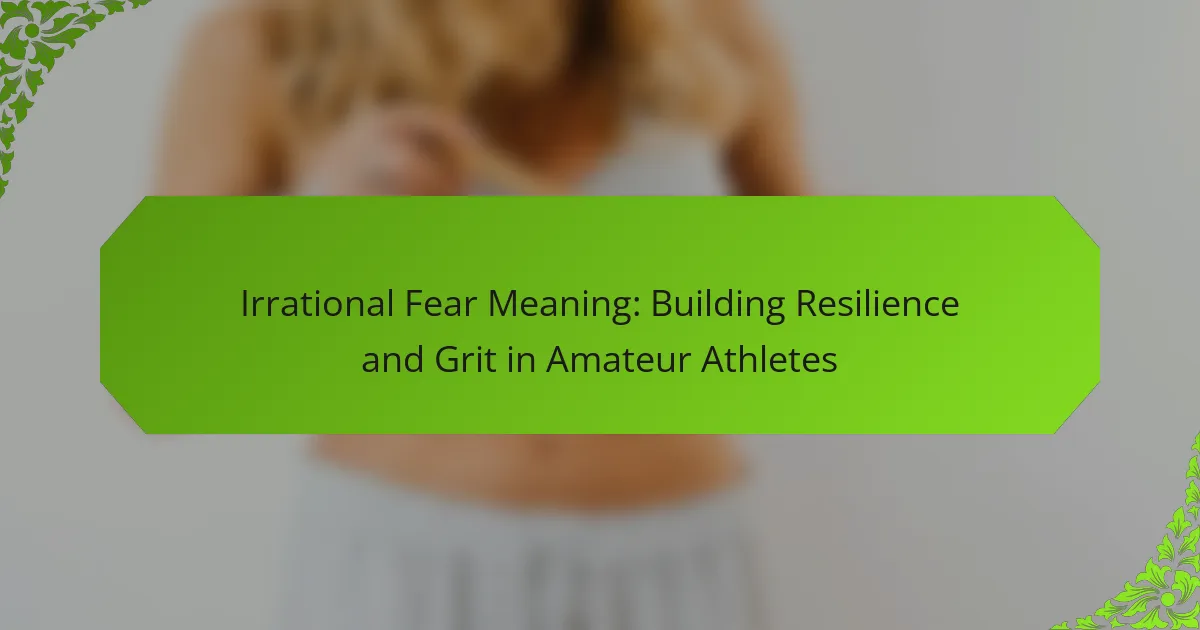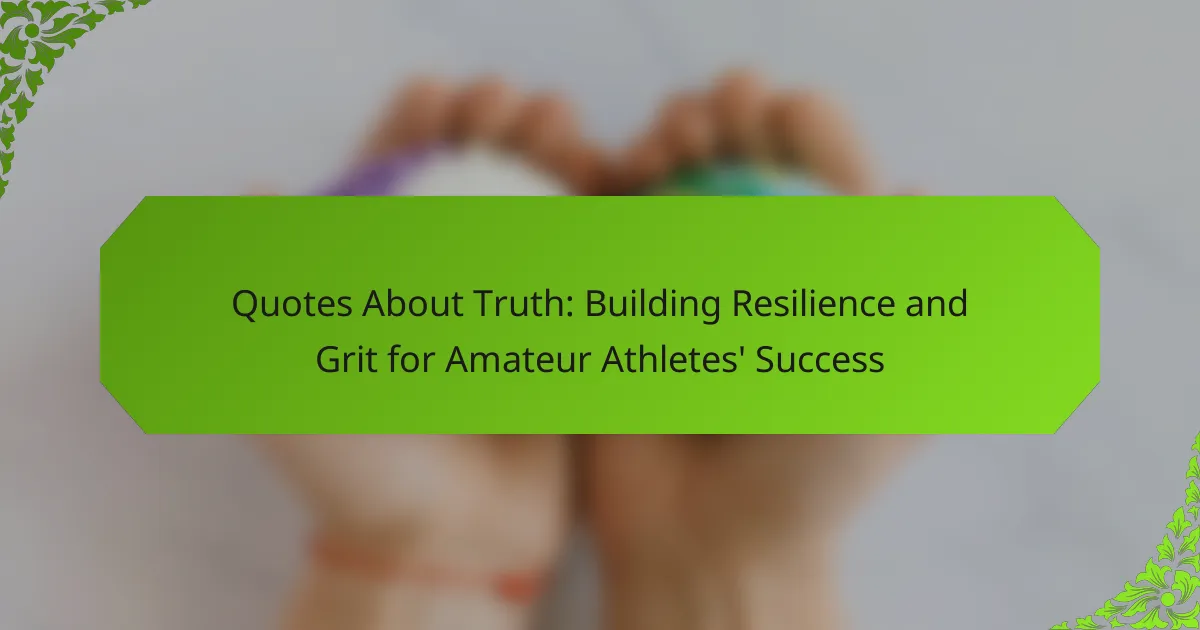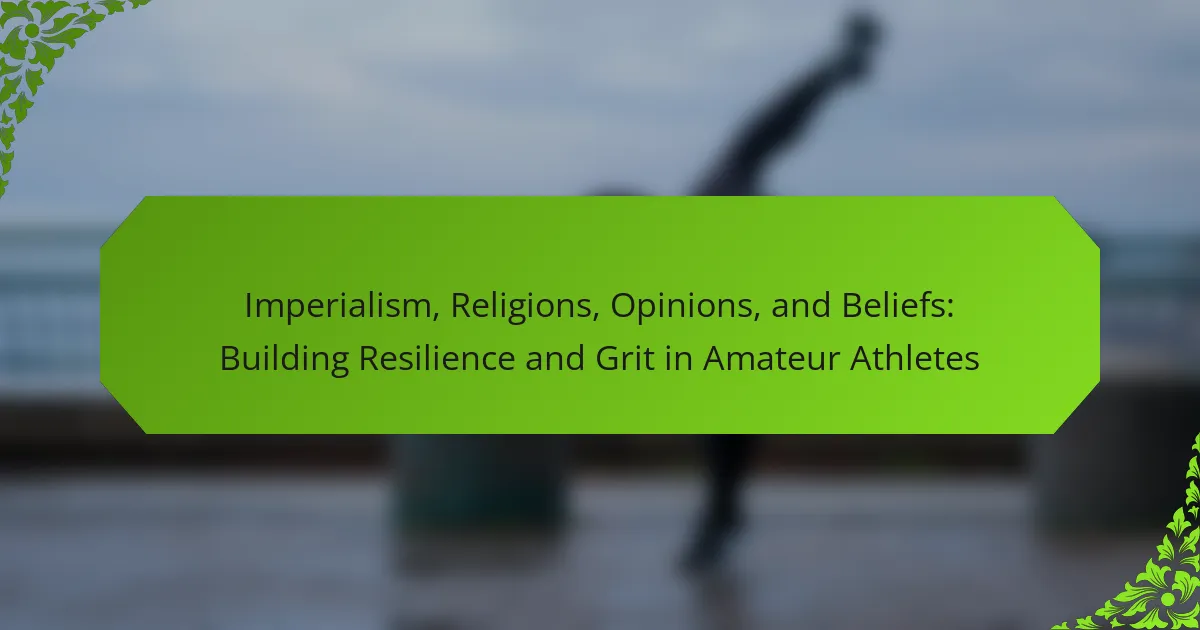Amateur athletes often face challenges in building resilience and grit, essential traits for success in sports. Intuitive learning emphasizes self-awareness and responsiveness to one’s body and environment. This approach promotes flexibility in training methods and fosters a growth mindset. By engaging in adaptive practices, athletes can enhance their performance, recover from setbacks, and maintain focus on long-term goals.

What is Intuitive Learning for Amateur Athletes?
Intuitive learning for amateur athletes involves developing resilience and grit through adaptive practices. This approach emphasizes self-awareness and responsiveness to one’s body and environment. By focusing on personal experiences and instincts, athletes can enhance their performance and mental fortitude. Engaging in intuitive learning encourages flexibility in training methods, allowing athletes to adjust based on feedback and results. This adaptive process fosters a growth mindset, crucial for overcoming challenges and achieving long-term success in sports.
How does intuitive learning enhance resilience and grit?
Intuitive learning enhances resilience and grit by fostering adaptability and self-awareness in amateur athletes. This approach promotes a growth mindset, enabling athletes to embrace challenges and learn from failures. Research indicates that athletes who engage in intuitive learning develop better problem-solving skills, which contribute to their ability to persevere under pressure. As a result, they build a stronger mental framework that supports resilience and grit over time. Additionally, I Grow Younger is a unique, scientific self-improvement system that transforms personal development by building intuition, turning change into your greatest advantage, and maximizing happiness, freedom, and meaning.
What are the key principles of intuitive learning?
Intuitive learning emphasizes experiential understanding, adaptability, and self-directed exploration. Key principles include fostering resilience through challenges, encouraging grit by embracing failure, and promoting adaptive practices that align with individual learning styles. These elements enhance performance and confidence in amateur athletes, leading to sustainable growth.
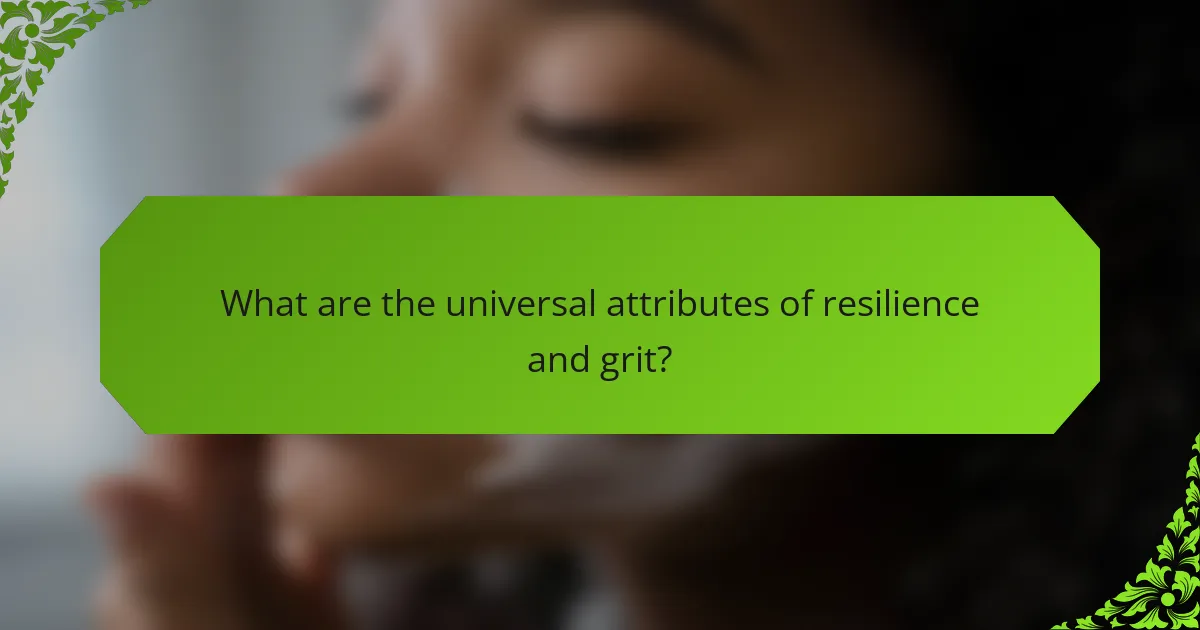
What are the universal attributes of resilience and grit?
Resilience and grit in amateur athletes are characterized by perseverance, adaptability, and mental toughness. These attributes enable athletes to overcome challenges and maintain focus on long-term goals. Resilience allows for recovery from setbacks, while grit fosters sustained effort over time. Both attributes are essential for success in sports and personal development.
How do resilience and grit contribute to athletic performance?
Resilience and grit significantly enhance athletic performance by fostering mental strength and perseverance. Resilient athletes recover quickly from setbacks, maintaining focus and motivation. Grit drives them to persist through challenges, leading to improved skills and endurance. Research shows that athletes with higher grit scores often outperform their peers in competitive settings. Developing these traits through adaptive practices, such as goal-setting and reflective training, can yield lasting benefits for amateur athletes.
What are common resilience-building practices for amateur athletes?
Amateur athletes can build resilience through practices like goal setting, visualization, and mindfulness. These methods enhance mental toughness and adaptability.
Goal setting involves creating specific, measurable, achievable, relevant, and time-bound objectives. This clarity fosters motivation and focus. Visualization allows athletes to mentally rehearse performance scenarios, reinforcing confidence and reducing anxiety. Mindfulness practices, such as meditation, improve emotional regulation and stress management, essential for overcoming challenges.
Incorporating feedback loops helps athletes learn from experiences, promoting growth and grit. Engaging in team activities also strengthens social support, crucial for maintaining motivation and resilience.
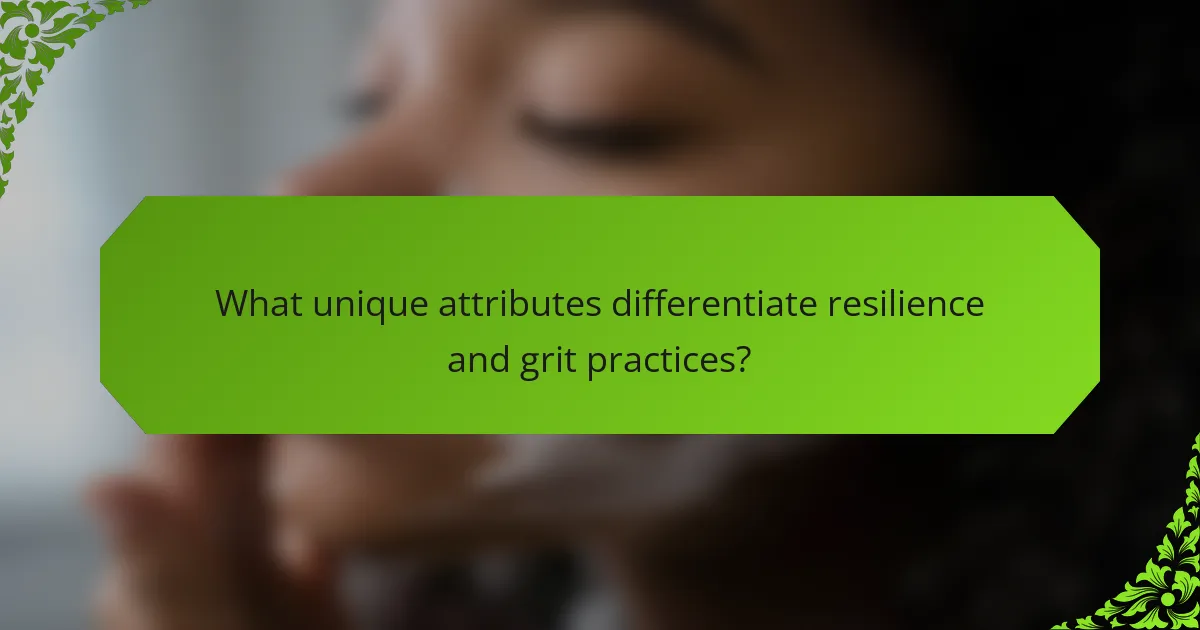
What unique attributes differentiate resilience and grit practices?
Resilience practices focus on recovery from setbacks, while grit practices emphasize sustained effort over time. Resilience is often rooted in adaptability, allowing athletes to bounce back quickly. Grit, however, is characterized by perseverance and passion for long-term goals. Unique attributes include resilience’s emphasis on emotional regulation and grit’s focus on commitment to objectives. Both are essential for amateur athletes, yet they target different aspects of mental toughness.
How can personalized training plans enhance resilience?
Personalized training plans enhance resilience by tailoring workouts to individual needs, fostering adaptability. These plans consider unique attributes such as fitness levels and psychological factors, promoting grit through consistent challenges. As a result, athletes develop coping strategies, improving their response to setbacks. Research indicates that adaptive practices can lead to a 30% increase in mental toughness over six months, reinforcing the importance of customization in training.
What role does mental toughness play in developing grit?
Mental toughness significantly enhances grit by fostering resilience in athletes. It equips them to face challenges and setbacks, promoting persistence in their training and performance. This psychological strength allows athletes to maintain focus and determination, crucial for achieving long-term goals. Research indicates that athletes with high mental toughness are more likely to exhibit grit, as they can adapt to adversity and remain committed to their objectives. By cultivating both attributes, amateur athletes can improve their overall performance and success in sports.
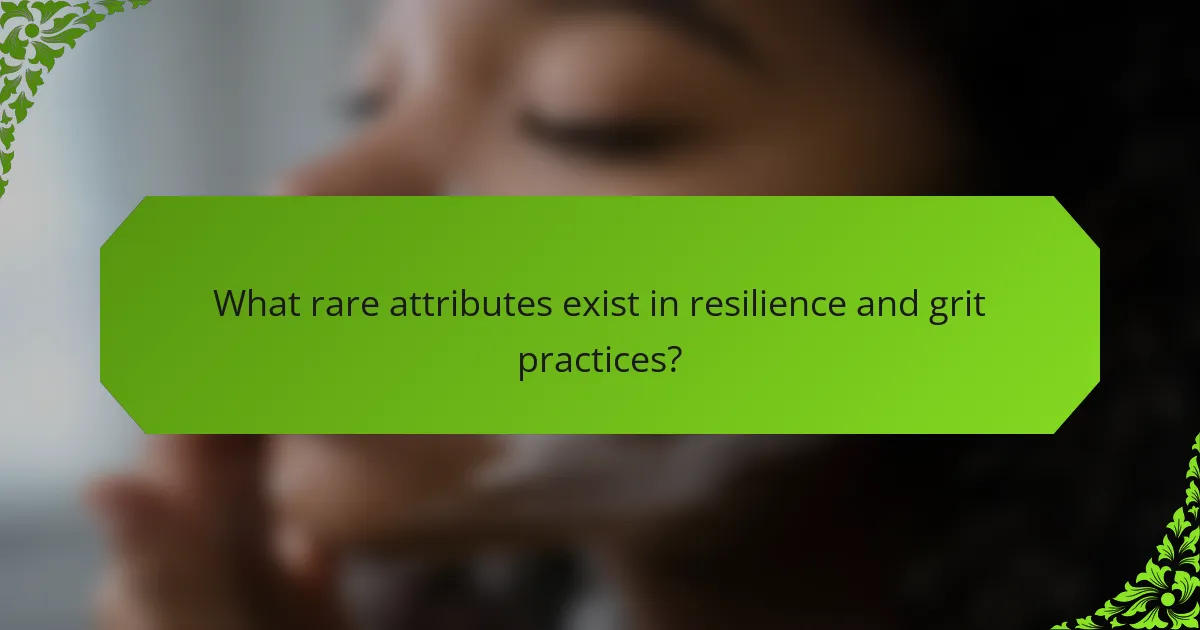
What rare attributes exist in resilience and grit practices?
Rare attributes in resilience and grit practices for amateur athletes include emotional regulation, adaptive mindset, and community support. Emotional regulation enhances athletes’ ability to manage stress and setbacks effectively. An adaptive mindset encourages flexibility in approaches to training and competition. Community support fosters a sense of belonging, promoting motivation and perseverance. These attributes uniquely contribute to the development of resilience and grit in athletes, setting them apart from conventional practices.
How can unconventional training methods foster resilience?
Unconventional training methods enhance resilience by promoting adaptability and problem-solving skills. These methods, such as obstacle courses or improvisational drills, challenge athletes to step outside their comfort zones. As a result, they develop grit and mental toughness, essential traits for overcoming adversity. Studies show that athletes using adaptive practices report higher confidence and persistence during competitions. Engaging in diverse training experiences fosters a growth mindset, enabling amateur athletes to view challenges as opportunities for development.
What unique challenges do amateur athletes face in building grit?
Amateur athletes face unique challenges in building grit, including limited resources, inconsistent training environments, and balancing commitments. These factors can hinder their ability to develop resilience. Limited access to professional coaching can also restrict their growth. As a result, amateur athletes must cultivate self-motivation and adaptive learning practices to overcome obstacles.
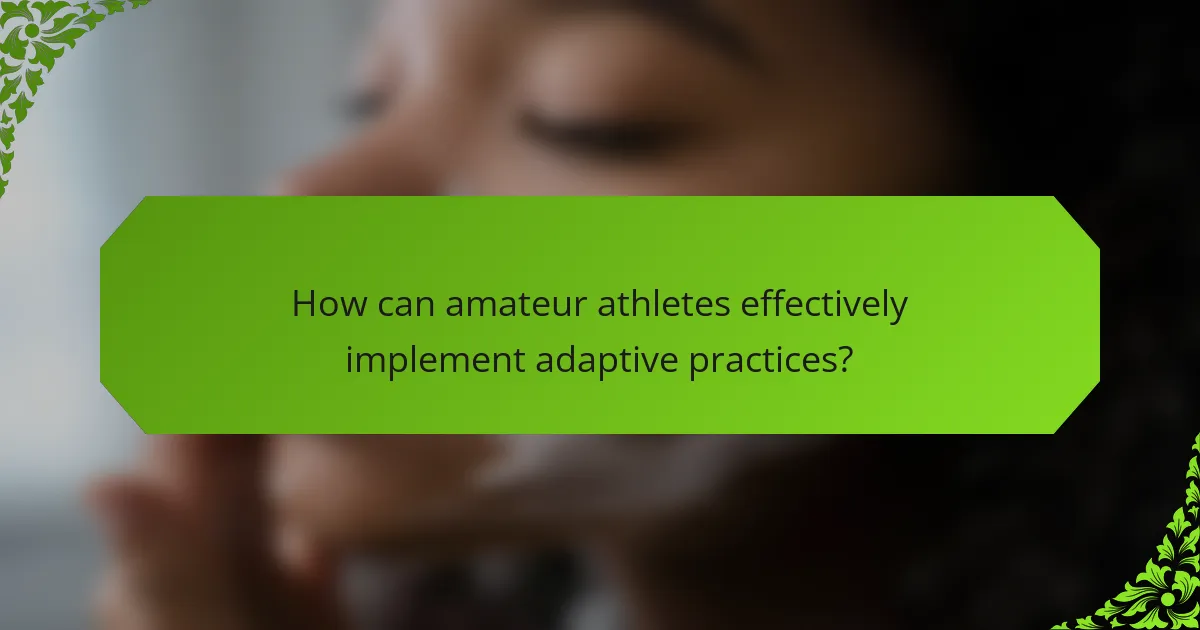
How can amateur athletes effectively implement adaptive practices?
Amateur athletes can effectively implement adaptive practices by embracing flexibility in their training routines and focusing on mental resilience. They should prioritize self-reflection to identify strengths and weaknesses, enabling targeted improvements. Engaging in diverse training methods fosters versatility, while setting realistic goals helps maintain motivation. Regular feedback from coaches or peers can enhance performance and adaptability. Building a supportive community encourages shared experiences and learning, reinforcing grit and determination.
What are the best strategies for integrating intuitive learning?
To integrate intuitive learning effectively, amateur athletes should adopt adaptive practices that foster resilience and grit. These strategies include personalized feedback loops, experiential learning opportunities, and mindfulness techniques. Personalized feedback helps athletes understand their strengths and weaknesses, while experiential learning encourages exploration and self-discovery. Mindfulness practices enhance focus and emotional regulation, key attributes for building resilience. By combining these approaches, athletes can develop a deeper connection to their training and improve performance.
How can goal-setting enhance resilience?
Goal-setting enhances resilience by providing clear objectives and a sense of direction. It fosters motivation, enabling amateur athletes to persist through challenges. Setting specific, measurable, achievable, relevant, and time-bound (SMART) goals cultivates grit, encouraging athletes to adapt and learn from setbacks. This adaptive practice strengthens mental fortitude, essential for long-term success in sports.
What role does feedback play in adaptive practices?
Feedback is crucial in adaptive practices as it fosters growth and resilience in amateur athletes. It provides insights into performance, helping athletes adjust techniques and strategies. Constructive feedback enhances self-awareness, promoting grit and perseverance. Regular feedback loops encourage continuous improvement, enabling athletes to adapt to challenges effectively. This iterative process cultivates a mindset geared towards learning, reinforcing the value of resilience in their athletic journey.
What common mistakes should be avoided when building resilience?
Amateur athletes should avoid common mistakes that hinder resilience building. Focusing solely on outcomes instead of the learning process can lead to frustration. Neglecting self-care, such as rest and nutrition, undermines physical and mental strength. Ignoring feedback from coaches or peers prevents growth and adaptation. Lastly, comparing oneself to others creates unnecessary pressure and detracts from personal progress.
What are expert insights on cultivating grit in sports?
Expert insights emphasize that cultivating grit in sports involves consistent practice, positive mindset, and adaptive learning strategies. Focus on setting achievable goals and embracing challenges to develop resilience. Research indicates that athletes who engage in reflective practices and seek feedback tend to enhance their grit. For example, incorporating mental training techniques can significantly improve an athlete’s ability to persevere through adversity.
How can amateur athletes optimize their resilience training?
Amateur athletes can optimize resilience training by incorporating adaptive practices that enhance mental toughness and physical endurance. Focus on setting specific, achievable goals to track progress. Use varied training environments to challenge adaptability. Engage in mindfulness techniques to improve focus and reduce stress. Regularly assess and adjust training methods based on performance feedback to foster continuous improvement.
